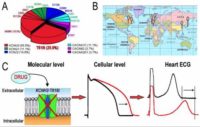02 Feb Short-QT
Posted at 23:08h
in
Distribution and Therapy of KCNH2-T618I Mutation in Short QT Syndrome. The proportion of KCNH2-T618I among genetic identified SQTS probands is the highest (25.9%, A), and the mutation is discovered in unrelated SQTS families from North America, Europe and Asia (B). KCNH2-T618I mutation leads to an increase in the repolarizing potassium current (IKr) and a decrease in action potential duration, which shortens the QT interval. With the IKr blocking effect by certain drugs, such as Quinidine, the action potential duration and QT/QTc get ameliorative, and VT/VF could be suppressed (C).

